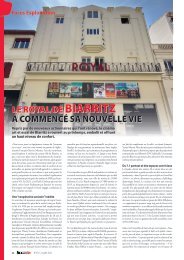Boxoffice-May.03.1952
Create successful ePaper yourself
Turn your PDF publications into a flip-book with our unique Google optimized e-Paper software.
MORE POP TO THE<br />
POUND<br />
Continued horn page 16<br />
in a yield test. This involved planting each<br />
hybrid in a separate row and growing them<br />
to maturity. Notes were taken on their<br />
growth characteristics such as ability to<br />
withstand windstorms and the attacks of<br />
insects and diseases. Each row was harvested<br />
separately and the yield obtained.<br />
About 20 representative ears from each row<br />
were dried carefully to the right moisture<br />
and popped to obtain popping volume and<br />
notes on the characteristics of the popped<br />
flake. These notes consisted of a score or<br />
rating on color, hull, shape, size, tenderness<br />
and flavor. On the basis of the information<br />
obtained from these tests a<br />
hybrid was selected for commercial production.<br />
It should be obvious that this program<br />
has involved an enormous amount of<br />
careful, painstaking research carried on<br />
over a period of about 12 years. During the<br />
time that the hybrid popcorn breeding program<br />
has been carried on at Iowa State college<br />
three complete cycles as described<br />
above have been completed and a fourth is<br />
well on its way.<br />
TEN NEW HYBRIDS RELEASED<br />
The popcorn breeding program at Iowa<br />
State college has resulted in the release of<br />
ten different commercial popcorn hybrids,<br />
three of which were not given official re-<br />
lease numbers. Of the last three to be released,<br />
lopop 5 and 7 are white or Jap<br />
hull-le.ss type and lopop 6 is yellow. All three<br />
stand better, yield better and are more<br />
resistant to insects and diseases than the<br />
open-pollinated varieties of similar type.<br />
But in the characteristic of most interest<br />
to the commercial popper, popping expansion,<br />
they are decidedly better than their<br />
open-pollinated ancestors. The two white<br />
hybrids have a popping expansion of 31.7<br />
for lopop 5 and 33.0 for lopop 7 as an<br />
average for a three-year period. These<br />
volumes are much higher than the old Jap<br />
hull-less variety. In addition, both of these<br />
hybrids are high in eating quality, having<br />
a very tender flake, are free from coarse<br />
hull and of delicate flavor.<br />
«3!P»<br />
The<br />
Answer<br />
To Your<br />
Fountain<br />
Problems!<br />
Two Sure-Fire Money-Makers<br />
Sell Soft Drinks and Ice Cream at a Sweet Profit!<br />
The DRINCOLATOR<br />
Dispenses 2 carbonated drinks<br />
and one non-carbonated drink<br />
. . . has a 12-gaIlon syrup capacity,<br />
equal to 1500 6-ounce<br />
drinks . . . has a constant flowvalve,<br />
enabling the operator to<br />
sell any size drink.<br />
Both Units are compact, attractive, durable.<br />
story from<br />
The ICECREAMOLATOR<br />
Stops them—tells them—sells<br />
them, puts the ice cream and<br />
pops in the spotlight where<br />
they're seen, wanted, bought!<br />
Takes only 5'/2 square leet of<br />
floor space.<br />
Get the complete profit<br />
THE DRINCOLATOR-ICECREAMOLATOR CORPORATION<br />
A Diyiiion Of<br />
THE YOUNGSTOWN WELDING & ENGINEERING COMPANY<br />
3700 Oakwood Avenue Youngstown 9, Ohio<br />
HIGH VOLUME AND TENDER FLAKE<br />
The new yellow hybrid, lopop 6, has<br />
shown even greater superiority over the<br />
open-pollinated yellow varieties. lopop 6,<br />
as an average for the last four years, has<br />
popped 35.1 volumes or 15 volumes better<br />
than the average for five of the old varieties,<br />
lopop 6, in addition, has an extremely<br />
tender flake ( too tender for some commercial<br />
uses > , thin hulls, an attractive color<br />
and excellent flavor.<br />
Perhaps some do not realize how important<br />
popping volume is to the commercial<br />
popper. Some dollars and cents comparisons<br />
may help to visualize its importance.<br />
By taking an average of the standard size<br />
popcorn bags used by three large popcorn<br />
stands it was found that a 100-pound bag<br />
of 26 volume corn would give a return of<br />
$115, 100 pounds of 30 volume corn returned<br />
$133 and 34 volume corn, $154. In<br />
other words each volume increase meant<br />
an increase of about $4.50 from a 100-<br />
pound bag. These figures show the importance<br />
of the popcorn breeding program<br />
to the commercial popper.<br />
BETTER CORN — MORE SALES<br />
There is little doubt that the great increase<br />
in sales of popped corn can be partly<br />
credited to the better quality of the product.<br />
This, in turn, is largely the result of<br />
the better hybrid popcorn being used by<br />
the popcorn industry. But even good hybrid<br />
popcorn must be processed and delivered<br />
to the commercial popper with the<br />
proper moisture and quality to give its full<br />
potential for high volume. Good breeding<br />
and good processing together have made<br />
popcorn of today one of the best examples<br />
of the ways in which research has been of<br />
value to the producer, the industry and the<br />
public.<br />
The Manley Co. believes the best way to<br />
handle popcorn is to buy corn in tins or<br />
100 pound bags. For small users, the tins<br />
keep the corn just right: for large users,<br />
the bags go so fast that moisture is no<br />
problem. However, in case you have some<br />
loose corn that has dried out, try this<br />
stunt: Saturate strips of paper toweling<br />
with a strong salt solution. Place popcorn<br />
in jar, scatter salt-water strips through it,<br />
and seal for 10 days.<br />
18 The MODERN THEATRE SECTION;

















